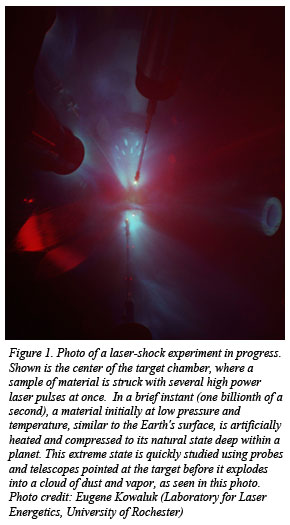The mantles of Earth and other rocky planets are rich in magnesium and oxygen. Due to its simplicity, the mineral magnesium oxide is a good model for studying the nature of planetary interiors. Carnegie's Stewart McWilliams and colleagues from Lawrence Livermore National Laboratory and the University of California – Berkeley, including CDAC Steering Committee Member Rip Collins (LLNL), former CDAC Partner Raymond Jeanloz (Berkeley) studied how magnesium oxide behaves under the extreme conditions deep within planets and finds evidence that alters our understanding of planetary evolution. 
Magnesium oxide is particularly resistant to changes when under intense pressures and temperatures. Theoretical predictions claim that it has just three unique states of different structures and properties at the conditions of planetary interiors: solid under ambient conditions (such as on the Earth’s surface), liquid at high temperatures, and another structure of the solid at high pressure, which has never been observed in nature or in experiments in this material.
The researchers observed magnesium oxide between pressures of about 3 million times normal atmospheric pressure (0.3 terapascals) and then up to 14 million times atmospheric pressure (1.4 terapascals) with temperatures reaching as high as 90,000 degrees Fahrenheit (50,000 Kelvin), conditions that range from those at the center of our Earth to those of larger exoplanets and Super Earths. Their observations indicate substantial changes in molecular bonding as the magnesium oxide responds to these various external conditions, including transformation to a new high-pressure solid phase. This pioneering study takes advantage of new laser techniques to explore the nature of the materials that comprise the wide array of planets being discovered outside of our solar system. These methods allow investigations of the behavior of these materials at pressures and temperatures never before explored experimentally.
In fact, when melting, there are signs that magnesium oxide changes from an electrically insulating material like quartz (meaning that electrons do not flow easily)  to a metal similar to Iron (meaning that electrons do flow easily through the material).
to a metal similar to Iron (meaning that electrons do flow easily through the material).
Drawing from these and other recent observations, the team concluded that while magnesium oxide is solid and non-conductive under conditions found on Earth in the present day, the early Earth’s magma ocean might first been able to generate a magnetic field. Likewise, this metallic, liquid phase can exist today in the deep mantles of super-Earth planets, as can the newly observed solid phase
[R. S. McWilliams et al., Science DOI:10.1126/science.1229450 (2012)].
